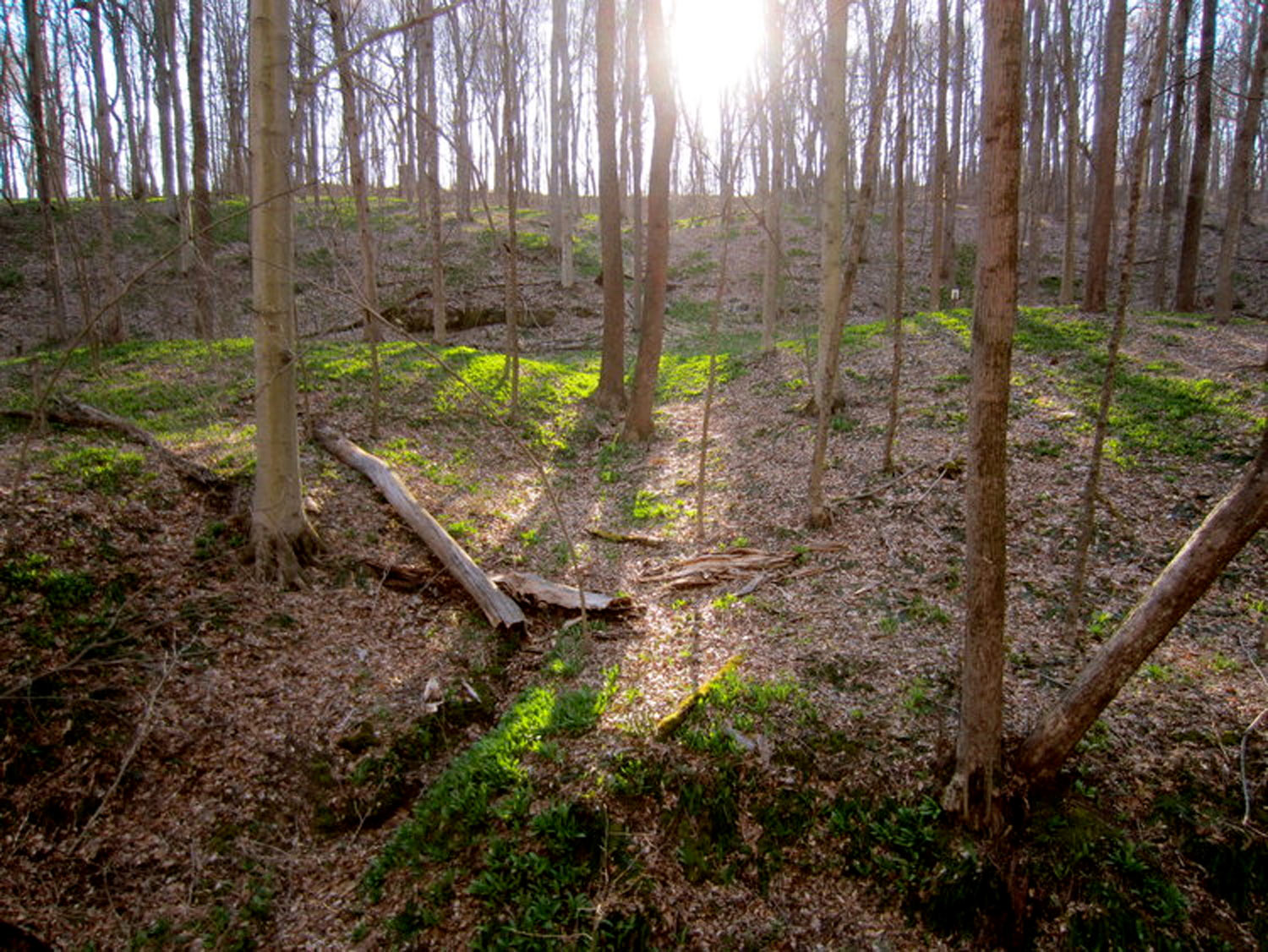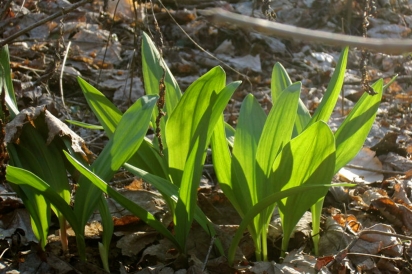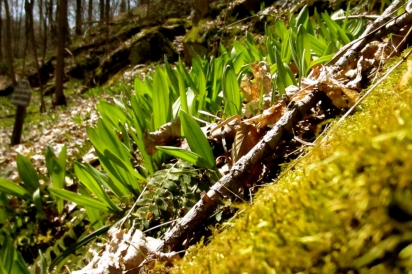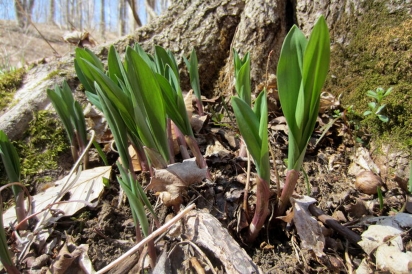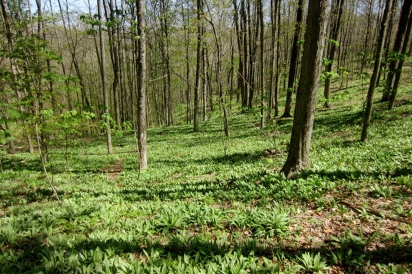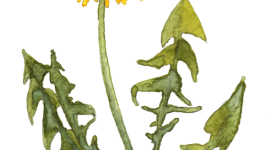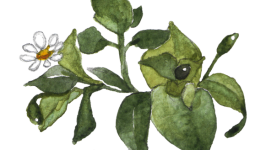The Wild Ramp
Take a walk down south through the Wayne National Forest and you might spy the emerald flushes of the ephemeral, edible wild ramp (Allium tricoccum). “Ramps are a spring tonic—one of the first green things to come up,” says Chip Carroll, land steward at the national nonprofit United Plant Savers (UPS) in Rutland, Ohio. “They would have been a critical early spring food source for ancient peoples right through modern times.”
Covering the forest floor, signaling the beginning of springtime in Appalachia, ramps belong to the allium family, and are considered a woodland medicinal. Different from cultivated crops, like tomatoes or broccoli, ramps require the fertile soil of the forest floor to survive and propagate. And in recent years ramps are in high demand: gourmet food markets and chefs at high-end restaurants want them, and local food lovers, like you, want them, too. When you visit the farmers market this spring they’re the native edible to look for in April and early May.
Yet ramps, because of demand, have become at risk of being over-harvested from the wild at an unsustainable rate. In 2016 UPS listed ramps on their plant species “to-watch” list, along with other medicinal plant species, like arnica (Arnica spp.) and kava-kava (Piper methysticum).
“Conservative estimates suggest it would take at least five million plants annually to meet current market demand, but without official harvest data the true size of the market is unknown” writes Tanner Filyaw, Forest Botanicals Specialist and Educator at Rural Action in Athens, Ohio. “On a regional level,” says Tanner, “ramps are considered most threatened in the heart of their native range in central and southern Appalachia.”
The Other Garlic
The culinary world seeks wild ramps for their flavor and woodland mystique. Paired with venison, or sautéed with scrambled eggs, ramps provide the first saturation of sunlight and earth for the palate—they’re a taste of terrior. The bulb is a slender, white thing but packs a punch with its spicy, garlicky bite. The leaves are tamer and when picked young in early April offer sweet notes.
Like the fiddleheads of the ostrich fern (Matteuccia struthiopteris) in New England, ramps appear in a region that endures a long, harsh winter. They offer the first bit of nutrients from a bone-chilling season, acting as a cleansing tonic for the blood come springtime. The bulbs in particular are quite strong. The Cherokee harvested the leaves of ramps and used the bulb to expel intestinal worms when necessary—a wise approach worth noting for eaters and foragers today.
The beginning of April into the beginning of May is peak season when ramps are maturing as an edible, depending on where you are in Appalachia. Ramps have a unique growing cycle, forming leaves in the early spring, but losing them by early summer, leaving only the bulbs and flower stalk to persist for the remainder of the growing season. During the springtime, the leaves and bulb grow rapidly, taking advantage of abundant sunlight that penetrates the leafless canopy, and reaches the forest floor. This rush to feed allows the ramp bulb to store nutrients that will support the development of the flower stalk and seeds, throughout the summer months long after the leaves have died away. The seeds then fully ripen late August to early September, and give rise to a new crop of edibles.
The ramp seed is enclosed in a papery hull and each white spray of flowers on the stalk in autumn is triangular in shape. Seeds fall to the ground, making them gravity dispersed, and they’re very hard—birds and mammals don’t go eating ramp seeds. As a result, a ramp population in the forest can be very, very dense—the seeds don’t go wide; they stay close to home.
Leaves-Only, Please
“With habitat loss and over-harvesting, we’ve seen a decline in the population of many of these species,” says Chip when we talk about ramps and other woodland medicinals.
While forestland continues to be cleared for farming and urban development, leaving ramps without a home, wild populations face a more immediate risk this spring—being whole-plant harvested. While there is no allowable harvesting of ramps on state and federal land in Ohio (one must have permission to harvest from private land) foragers and even poachers nevertheless take to the forests and pull whole ramp plants out of the ground, bulbs and all. Yet ramps have a slow maturation rate—they require seven years to reach full maturity in the forest. Whole-plant harvesting of ramps kills the plant—no other ramps will emerge from it once it’s uprooted—and it ensures that the seed cluster that would have come in autumn will not be dispersed into the cool, leafy humus for the next season of plants to propagate.
“The big thing we’ve been pushing for specific to ramps is the transitioning of harvesters out of the whole-plant harvest and to the just-one-leaf-per-plant harvest technique,” says Chip. “We believe that will go a long way for the conservation of the species.”
UPS and conservationists are working to instill a mindset of “leaves only” with ramps, advising one leaf per plant be picked to ensure the sustainability of the whole plant. Yet today chefs and eaters want leaf and bulb—a hunger that is driving ramp populations down as uneducated foragers, and often times poachers looking for quick cash for their drug addiction, go harvesting for ramps.
Stewards like Tanner and Chip are committed to taming the craving for ramps with projects like the Appalachian Beginning Forest Farmer Program (ABFFP), a collective of forestland owners, universities and governmental and non-governmental organizations working to educate people about forest-grown medicinal plants like ramps and help landowners farm their forest for these native edibles.
“We’re kind of on a precipice of a transition within the industry,” says Chip, “and also with consumers demanding cultivated products—it’s helping drive this process. We’re hoping to transition a lot of what has been traditionally wild-harvested the last several decades into cultivated systems where we can produce them for the long-run.”
Farming the Wild
Taming a wild thing takes time. Bringing ramps into cultivation with programs like ABFFP requires educational programs, ongoing assessments, seed sales and trainings with landowners and farmers to see where the right habitats would be to pursue plantings and cultivations. And then there is the process of bringing the ramps to market once they’re cultivated and harvested on a farmer’s land.
Over the past few years, Rural Action has helped 30 landowners develop detailed forest management plans to support forest farming enterprises in Appalachian Ohio, and typically engages between 300 and 500 landowners annually through forest farming workshops and events.
“When you’re starting from scratch,” says Tanner, “ramp cultivation is a multi-year investment.”
Yet the prospect of ramp cultivation may prove lucrative. According to Chip, more herbal businesses and consumers are demanding cultivated sources, instead of wild-crafted, for woodland medicinals like ramps. The only question is will chefs, markets and local food lovers start demanding a cultivated source for ramps, too?
“I think there is a real opportunity for people as ramps continue to grow in popularity,” says Chip. “There aren’t a lot of people cultivating them for restaurants and consumption. So as the plant continues to diminish in the wild and as interest continues to grow around the plant as an edible, I think growers could be well-positioned to have an economic benefit.”
And it’s not just farmers and landowners who are positioned to benefit. You can grow ramps, too.
“I’m growing ramps in a raised bed here at home,” says Chip, “but it’s under some shady trees part of the yard and I’ve incorporated some native forest soil into that bed to help them along.”
Ramps require rich soil and shade. “If folks have a shady spot and a little bit of woodland,” says Chip, they’re perfectly suited to begin cultivating their own bed of ramps.
And while ramp seeds can be hard to find on the market, organizations like Rural Action and UPS have annual seed sales in the fall for landowners, farmers and growers.
So even though ramps and their medicinal benefits maintain a stronghold in the forests of Appalachia thanks to Chip, Tanner and others, what was once wild and free may become more like broccoli or tomatoes in how it’s grown, harvested and brought to market.
“A major goal of Rural Action’s Sustainable Forestry Program has been trying to find the intersection between stewardship harvesting and commercial sales,” says Tanner. “We’d really like to see more forest landowners, farmers and farmers market vendors selling cultivated or sustainably harvested ramps, and try to get away from the wild market as much as possible.”
Learn more about United Plants Savers on their website and check out their upcoming symposium "The Future of Ginseng and Wild Botanicals." Please note a visit to UPS in Rutland, Ohio is by appointment only.


